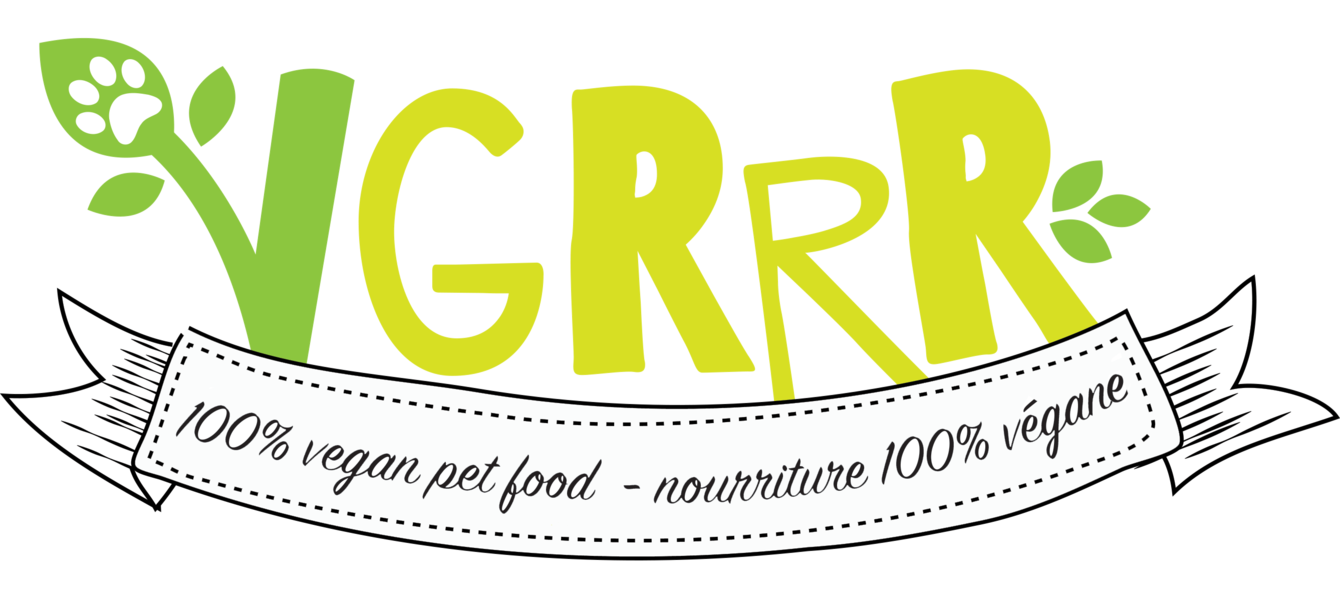Welcome to Part One of this series on homemade, plant-based pet nutrition products!

If your feline companion is due for some variety, now’s the ideal time to experiment with homemade cat food recipes! Most of the required ingredients can be found right in your pantry: seitan, textured soy protein, hemp hearts, squash… The only thing missing is a plant-based supplement for cats. You can easily order VGRRR’s VegeCatTM supplement online or request delivery in Montreal—no need to leave the house! Since plant-based food staples lack taurine, vitamin D2 and arachidonic acid, supplementing DIY kibble and wet food is essential. Kitty can’t go without ’em! Read on to know the basics and become your furry friend’s personal chef 👨🍳
- Transition gradually: Mix a small amount of the new food in with the old food and adjust the proportions over two weeks or longer. Let your cat show you how quickly he or she is willing to transition. Morning is the best time to begin introducing new food because the appetite is stronger. Adding extra nutritional yeast or sauces for flavor (see tip #5) can help entice your cat during the transitional period.
- Add enzymes: Almost every process in the body requires enzymes. Digestion is no different. Digestive enzymes are produced in the body and found in plants and raw foods, yet are destroyed in cooked foods. We recommend adding plant-derived enzymes (lipase, amylase, protease, and cellulase) to any cooked food to help Kitty digest carbohydrates. Prozyme® Plus maximizes the absorption of valuable nutrients by up to 71% and greatly aids digestion. Note that a little raw food won’t be enough to compensate for the enzyme loss in cooked food.
- Use high-protein ingredients: Gluten flour, the protein part of wheat, contains 75% protein by dry weight. Also labelled as vital wheat gluten or instant gluten, it is the best choice for cats. Each cup of this flour makes 3 1/2 cups of seitan, a great imitation meat product. You can also use textured soy protein (also known as textured vegetable protein, or TVP®) in your homemade cat food: just mix 7/8 cup of boiling water with a cup of the soy protein. If you use tofu, go for an extra-firm variety made with calcium sulfate to keep magnesium to a minimum.
- Strike the right fatty acid balance: Essential Fatty Acids (EFAs) are particularly important to your animal’s well-being, as is the ratio of omega-6 to omega-3 fatty acids. Stay tuned this week for VGRRR-exclusive recipes formulated with the right oil blends. Omega-3 fatty acids are found in flaxseed oil, as well as olive oil, canola oil and hemp hearts. Olive and canola oils meet the omega-6 fatty acid requirements. Do not substitute oils recommended in the recipes! To ensure great taste, store oils in the refrigerator and taste to make sure they’re not rancid.
- Don’t forget palatability: Just like you and me, cats like rich, moist and flavourful foods. Coat your homemade concoctions with a “sauce” made from squash or avocado puree, sugar-free canned corn pureed with nori, or a drizzle of oil. However, avoid using more than 10% whole vegetable food in your cat’s diet, which could dilute protein content and other nutriments. Nutri-Yeast will be your best ally in transitioning Kitty to a plant-based diet. This VGRRR-exclusive yeast formulated just for pets is important for protein, B-spectrum vitamins and flavour. Also, make sure you feed your cat many times per day to ensure the food is fresh. You can prepare a large batch of moist food and freeze individual portions in silicone ice cube trays.
- Test urine PH: Cats should have an acidic urine pH of 6.0 to 6.5. It is wise to test the urine at home or at a veterinarian’s office before switching the diet and about 3-weeks after transitioning to a new diet, then periodically after – twice in the first year and yearly after. Some cats are adversely affected by high dietary magnesium and exhibit urinary problems such as stone formation. For those cats, use lower magnesium recipes. Also, avoid adding more than a teaspoon per day of nori to your cat’s food to prevent alkalinity. If you notice an alkaline urine problem, please contact us or consult with your veterinarian to discuss acidification. Vitamin C or an increase in wet food intake can help restore balance.
We hope this guide will help you understand your cat’s needs a little better and inspire you to whip up some recipes. Stay tuned for our very favourite dry kibble and wet food recipes, specially formulated to meet your furry friend’s needs!

Hey there! I appreciate this article. My understanding is that soya is dangerous to kitties, have you find evidence to the contrary? Thank you!
Thank you! Love your site! Where would I find your vegan recipe for cats?